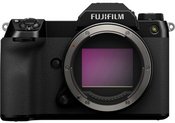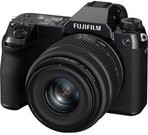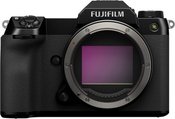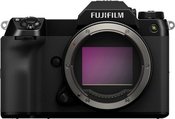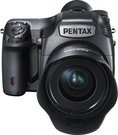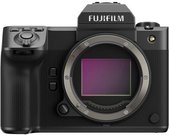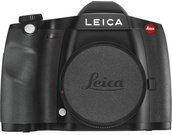Medium format refers to cameras and photo equipment that have a sensor or matrix larger than a "full frame" sensor. A full frame sensor measures 24 mm × 36 mm (0.94 in × 1.42 in), which corresponds to the standard 135 film size. Any sensor or film size larger than this is considered "large format photography." Some examples of medium format camera sensors include: Phase One's P65+ digital back with Dalsa's 53.9 mm × 40.4 mm (2.12 in × 1.59 in) sensor, Leica's "S-System" DSLR with a 45 mm × 30 mm (1.8 in × 1.2 in) sensor, Hasselblad X1D, a 50MP medium-format mirrorless camera, with a 44 mm × 33 mm (1.7 in × 1.3 in) CMOS sensor, and Fujifilm GFX 50S, a medium format mirrorless camera with a 43.8 mm × 32.9 mm (1.72 in × 1.30 in) CMOS sensor.
In today's photography world, the term MEDIUM-FORMAT CAMERAS has become somewhat ambiguous after the introduction of digital cameras. In the past, when film reigned supreme in the photography world, there were many different film formats compatible with various analog cameras, including medium format and the popular 135 film frame (36x24 mm), which in digital SLRs and mirrorless cameras is commonly referred to as "full-frame" format. However, nowadays, the variety of camera formats is mainly limited to two: the "APS-C" sensor and the full-frame format, which are the most common (if not the only) formats used in digital cameras.
THE ABILITY TO ACHIEVE UNMATCHED IMAGE QUALITY
Despite the widespread popularity of these two aforementioned formats, medium format usage has never ceased. In fact, due to its ability to deliver unparalleled image quality, medium format cameras remain preferred in commercial photography. In recent years, the popularity of medium format photography has risen due to the return to film and the fact that famous brands like "Fujifilm," "Leica," and "Hasselblad" have introduced their digital medium format cameras.
WHAT IS MEDIUM FORMAT?
A medium-format camera is any camera that uses a 120 film roll or a digital image sensor that emulates this size. Images captured in this format are slightly smaller than large-format film (102x127 mm). However, they are much larger than those captured using full-frame sensors or 135 film. There is no standard medium format size, and it varies depending on the manufacturer.
Medium-format cameras stand out for their ability to capture extremely high-quality images and reproduce colors almost flawlessly. As a result, these cameras are commonly used in fashion and advertising photography. Advertising, which requires exceptionally high-quality and detailed images, greatly benefits from the image quality of medium-format cameras. This is why these types of cameras are standard in most magazine cover photo shoots.
You can also see other examples of medium-format photos among famous fashion photographers like Terry O'Neill and David Bailey. These creators were well-known in the fashion photography world in the 1960s and 1970s. It is reported that both of them creatively used "Hasselblad" medium-format cameras for fashion shoots.
WHAT'S THE DIFFERENCE BETWEEN A MEDIUM-FORMAT AND A FULL-FRAME CAMERA?
The main comparison between medium-format and full-frame cameras starts with the sensor size. A full-frame camera uses a 35 mm film roll (or simulates it with a 36x24 mm sensor), while a medium-format camera’s sensor is larger than 36 mm and smaller than 100x130 mm (the size of a large-format sensor). The difference in sensor size leads to differences in image quality and weight. A medium-format camera guarantees better image quality, detail, and color accuracy. It's worth mentioning that a medium-format camera is not intended for video or high-speed continuous shooting, but it has an internal shutter and does not require synchronization with a flash. Therefore, you can use a medium-format camera for high-speed shooting.
FEATURES OF A MEDIUM-FORMAT CAMERA SYSTEM:
Higher-quality images. Due to the larger image area, medium-format cameras can produce images about 70% larger and with better resolution compared to images captured by full-frame cameras. Shallow depth of field: no wonder portrait and wedding photographers used medium-format cameras from the 7th to the 10th decades. There’s something magical that can be captured due to the shallower focus and depth, making them a natural choice for portraits. Cropping: some formats, especially 6×7, are much better suited for magazines than 35 mm.
Wider field of view. Medium-format cameras have a unique ability to combine the functions of a wide-angle and a long lens in one device. This allows for a wider field of view while also achieving background compression and a shallow depth of field, which are typical of long focal length lenses.
Exceptional look and feel. Even when viewing medium-format photos online, its signature "look" is clearly visible. Due to stunning colors, shallow depth of field, and the perception distortions we typically see from modern cameras, nothing is as beautiful and realistic as medium-format images. The resulting image always gives a more natural look, resembling the properties and dynamic range of what we see in real life.
Extraordinary versatility. When you can freely use interchangeable camera components, you can tailor the camera to meet your specific shooting needs. This also allows you to switch from film to digital camera (and vice versa). You can patiently practice the art of film photography.
Larger image sensor. The increased image sensors in medium-format cameras are much larger than the 35 mm full-frame sensors found in most high-end DSLR cameras and mirrorless cameras. In digital cameras, the size of the medium-format sensor typically ranges from about 43.8 × 32.9 mm to 53.7 × 40.2 mm. Larger image sensors usually produce images with much higher resolution.
Heavy and bulky body. Traditionally, medium-format cameras are larger and heavier than most cameras due to their large sensors. Fortunately, more and more camera manufacturers offer lighter and more compact camera bodies (in the form of mirrorless cameras) with the same medium-format shooting capabilities, such as the popular "Fujifilm GFX 50R," which is also compatible with "Capture One."
A wide range of sizes. Due to different medium-format film sizes and the ability to change film backs, photographers with medium-format film cameras can use different frame sizes and aspect ratios to make their images more varied. The same can be said for digital medium-format cameras, although you can’t just swap the sensor – you simply have the freedom to choose from various available models and pick a camera with a sensor size that fits your specific needs.




